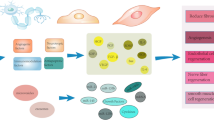Abstract
P2X1 receptors for ATP are ligand-gated cation channels, present on many excitable cells including vas deferens smooth muscle cells1,2,3,4,5. A substantial component of the contractile response of the vas deferens to sympathetic nerve stimulation, which propels sperm into the ejaculate, is mediated through P2X receptors1. Here we show that male fertility is reduced by ∼90% in mice with a targeted deletion of the P2X1 receptor gene. Male mice copulate normally—reduced fertility results from a reduction of sperm in the ejaculate and not from sperm dysfunction. Female mice and heterozygote mice are unaffected. In P2X1-receptor-deficient mice, contraction of the vas deferens to sympathetic nerve stimulation is reduced by up to 60% and responses to P2X receptor agonists are abolished. These results show that P2X1 receptors are essential for normal male reproductive function and suggest that the development of selective P2X1 receptor antagonists may provide an effective non-hormonal male contraceptive pill. Also, agents that potentiate the actions of ATP at P2X1 receptors may be useful in the treatment of male infertility.




Similar content being viewed by others
References
Burnstock,G. The past, present and future of purine nucleotides as signalling molecules. Neuropharmacology 36, 1127–1139 (1997).
Surprenant,A., Buell,G. & North,R. A. P2X receptors bring new structure to ligand-gated ion channels. Trends Neurosci. 18, 224–229 (1995).
Evans,R. J. & Surprenant,A. P2X receptors in autonomic and sensory neurons. Semin. Neurosci. 8, 217–223 (1996).
Brading,A. F. & Williams,J. H. Contractile responses of smooth muscle strips from rat and guinea-pig urinary bladder to transmural stimulation: effects of atropine and α,β-methyleneATP. Br. J. Pharmacol. 99, 493–498 (1990).
Collo,G. et al. Cloning of P2X5 and P2X6 receptors and the distribution and properties of an extended family of ATP-gated ion channels. J. Neurosci. 16, 2495–2507 (1996).
Valera,S. et al. A new class of ligand-gated ion channel defined by P2X receptor for extracellular ATP. Nature 371, 516–519 (1994).
Vulchanova,L. et al. Differential distribution of two ATP-gated ion channels (P2X receptors) determined by immunohistochemistry. Proc. Natl Acad. Sci. USA 93, 8063–8067 (1996).
Costa,S. L., Boekelheide,K., Vanderhyden,B. C., Seth,R. & McBurney,M. W. Male infertility caused by epididymal dysfunction in transgenic mice expressing a dominant negative mutation of retinoic acid receptors alpha 1. Biol. Reprod. 56, 985–990 (1997).
Allcorn,R. J., Cunnane,T. C. & Kirkpatrick,K. Actions of α,β-methylene ATP and 6-hydroxydopamine on sympathetic neurotransmission in the vas deferens of the guinea-pig, rat and mouse: support for co-transmission. Br. J. Pharmacol. 89, 647–659 (1986).
von Kugelgen,I., Bultmann,R. & Starke,K. Interaction of adenine nucleotides, UTP and suramin in mouse vas deferens: suramin-sensitive and suramin-insensitive components in the contractile effect of ATP. Naunyn Schmiedeberg's Arch. Pharmacol. 342, 198–205 (1990).
Khakh,B. S., Surprenant,A. & Humphrey,P. P. A. A study on P2X purinoceptors mediating the electrophysiological and contractile effects of purine nucleotides in rat vas deferens. Br. J. Pharmacol. 115, 177–185 (1995).
Burnstock,G. & Holman,M. E. The transmission of excitation from autonomic nerve to smooth muscle. J. Physiol. 155, 115–133 (1961).
Ralevic,V. & Burnstock,G. Receptors for purines and pyrimidines. Pharmacol. Rev. 50, 413–492 (1998).
Kenakin,T. in Pharmacologic Analysis of Drug-Receptor Interaction Vol. 3, 63–67 (Lippincott-Raven, Philadelphia, 1997).
Yang,L. & Clemens,L. G. Influence of male-related stimuli on female postejaculatory refractory period in rats. Physiol. Behav. 63, 675–682 (1998).
Anderson,R. A., Oswald,C., Willis,B. R. & Zaneveld,L. J. D. Relationship between semen characteristics and fertility in electroejaculated mice. J. Reprod. Fertil. 68, 1–7 (1983).
Hoffman,B. B. & Lefkowitz,R. J. in The Pharmacological Basis of Therapeutics (eds Hardman, J. G., Limbird, L. E., Molinoff, P. B., Ruddon, R. W. & Gilman, A. G.) Vol. 9, 199–248 (McGraw-Hill, New York, 1996).
Hedlund,H., Andersson,K. & Larsson,B. Effect of drugs interacting with adrenoceptors and muscarinic recetors in the epididymal and prostatic parts of the human isolated vas deferens. J. Autonom. Pharmacol. 5, 261–270 (1985).
Jacobson,K. A. et al. A pyridoxine cyclic phosphate and its 6-azoaryl derivative selectively potentiate and antagonize activation of P2X1 receptors. J. Med. Chem. 41, 2201–2206 (1998).
Hogan,B., Constantini,F. & Lacy,E. Manipulating the Mouse Embryo: A Laboratory Manual (Cold Spring Harbour, New York, 1986).
Lewis,C., Surprenant,A. & Evans,R. J. 2′,3′-O-(2,4,6-trinitrophenyl) adenosine 5′-triphosphate (TNP-ATP)—a nanomolar affinity antagonist at rat mesenteric artery P2X receptor ion channels. Br. J. Pharmacol. 1463–1466 (1998).
Acknowledgements
We thank L. Vulchanova and R. Elde for the P2X1 receptor antibody, B. Grubb and S. Giblett for help with the immunohistochemistry and C. d'Lacey for help with the confocal images. We also thank J. Luckett and S. Monkley for help at the bench and S. R. Nahorski for comments on the manuscript. This work was supported by the Medical Research Council and the Wellcome Trust.
Author information
Authors and Affiliations
Corresponding author
Rights and permissions
About this article
Cite this article
Mulryan, K., Gitterman, D., Lewis, C. et al. Reduced vas deferens contraction and male infertility in mice lacking P2X1 receptors. Nature 403, 86–89 (2000). https://doi.org/10.1038/47495
Received:
Accepted:
Issue Date:
DOI: https://doi.org/10.1038/47495
- Springer Nature Limited
This article is cited by
-
P2 purinergic receptor dysregulation in urologic disease
Purinergic Signalling (2022)
-
Identification of a subset of immunosuppressive P2RX1-negative neutrophils in pancreatic cancer liver metastasis
Nature Communications (2021)
-
Development of a P2X1-eYFP receptor knock-in mouse to track receptors in real time
Purinergic Signalling (2019)
-
Role of P2X4 Receptor in Mouse Voiding Function
Scientific Reports (2018)
-
Effects of long-term treatment with haloperidol, clozapine and aripiprazole on mice isolated vas deferens
International Urology and Nephrology (2017)





